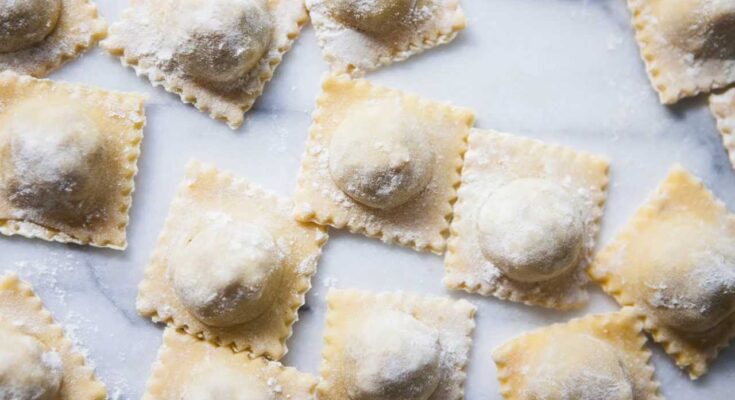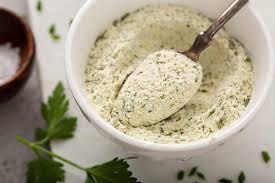Ravioli Dough Recipe: Who doesn’t love a plate of pillowy, stuffed ravioli drenched in butter or tomato sauce? The true magic of ravioli begins not with the filling, but with the dough itself. Making homemade ravioli dough might sound intimidating, but it’s surprisingly simple and deeply rewarding. If you’ve ever tasted freshly made pasta, you know the difference—it’s not just food, it’s an experience.
Ravioli dough is more than just a vessel; it’s a delicate casing that should complement the filling without overpowering it. When done right, it becomes silky, slightly chewy, and tender enough to melt in your mouth. Unlike dried pasta, which often feels stiff or chewy, fresh ravioli dough offers a softness and richness that turns a regular meal into a restaurant-worthy event.
This step-by-step guide is crafted to walk you through every part of the process. From choosing the right flour to rolling it to perfection, we’ll cover everything you need to know to master this Italian classic.
Why Make Your Own Ravioli Dough?
There’s something almost meditative about making pasta from scratch. It connects you with the ingredients, the process, and the centuries-old tradition of Italian cooking. Making ravioli dough yourself gives you full control over the flavor, texture, and ingredients. Want to avoid preservatives and additives? Done. Want to experiment with different types of flour or colors? Go for it.
Homemade dough is fresher, more flavorful, and more versatile than anything you can buy at the store. It might take a bit more effort than ripping open a package, but the results are worth every minute. Plus, it’s a fun activity to do with friends or family—kids especially love getting their hands in the flour.
And here’s the best part: once you learn the basics, you’ll be able to whip up fresh pasta for not just ravioli, but fettuccine, tagliatelle, tortellini—you name it.
The Beauty of Fresh Pasta vs. Store-Bought
Store-bought pasta has its place—it’s convenient, cheap, and easy to store. But when it comes to ravioli, store-bought sheets or pre-made ravioli often fall short. They’re usually thick, rubbery, and lack that delicate texture that fresh pasta brings to the table.
Fresh pasta dough, especially when made for ravioli, is thin yet strong enough to hold fillings, pliable to shape, and tender to bite. It absorbs sauces better, cooks faster, and tastes miles better.
Think of it like the difference between instant coffee and a perfectly brewed espresso. Both will give you caffeine, but only one delivers a rich, flavorful experience. With just a handful of pantry staples, you can create pasta that rivals what you’d get at a top Italian restaurant.
List of Ingredients You’ll Need
Before you begin mixing and kneading, let’s talk ingredients. The beauty of ravioli dough is that it’s incredibly simple. You probably have everything you need already in your kitchen.
Essential Ingredients
To make basic ravioli dough, you’ll need:
- All-purpose flour or “00” flour – About 2 cups (250g)
- Large eggs – 3 whole eggs
- Salt – A pinch for flavor
- Olive oil (optional) – 1 tablespoon, for elasticity and flavor
Let’s break it down.
Flour: All-purpose flour works great, but if you want a truly authentic Italian texture, go for “00” flour. This ultra-fine flour gives the dough a smoother consistency and makes it easier to roll thin.
Eggs: The standard ratio for pasta dough is 1 egg per 100 grams (about 3.5 ounces) of flour. Eggs add richness and structure to the dough. Room-temperature eggs are easier to mix and create a better dough.
Salt: This is just for seasoning the dough. It doesn’t need to be much, but it makes a difference in flavor.
Olive Oil: Though optional, a touch of olive oil adds a smooth texture to your dough and helps it roll out more easily. Some purists skip it, but it’s great for beginners.
Optional Add-Ins for Flavor and Color
Want to level up your ravioli dough? Try these creative add-ins:
- Spinach puree – for a green, earthy dough
- Beet juice – to make the dough a vibrant pink
- Squid ink – adds color and a briny flavor, great for seafood ravioli
- Herbs (like basil or parsley) – finely chopped and mixed into the dough
These extras don’t just look pretty—they can subtly change the flavor of your ravioli to match different fillings and sauces.
Kitchen Tools You’ll Need
Making ravioli dough doesn’t require fancy equipment, but a few tools will make your life a lot easier:
- Mixing bowl or clean countertop for mixing the dough
- Fork or dough scraper to help incorporate the eggs
- Rolling pin or pasta machine to flatten the dough
- Knife or pasta cutter to cut the ravioli sheets
- Plastic wrap for resting the dough
- Bench scraper (optional) – makes cleanup and kneading easier
That’s it—minimal tools, maximum flavor. Now let’s move into the actual dough-making process step by step.
Step-by-Step Guide to Making Ravioli Dough
Making ravioli dough is like working with clay—it starts rough but transforms into something smooth and pliable with just a bit of love and time. This step-by-step breakdown will take you from raw ingredients to a beautifully elastic dough, ready for stuffing.
Step 1: Measuring and Preparing the Ingredients
Measure 2 cups of all-purpose flour, 3 large eggs, ½ teaspoon of salt, and 1 tablespoon of olive oil. For smoother dough, use room-temperature eggs.
Step 2: Making a Well in the Flour
On a clean surface or in a large bowl, form the flour into a mound. Use your hands to create a deep well in the center — this will hold your wet ingredients.
Step 3: Incorporating the Eggs
Crack the eggs into the well, add olive oil and salt, and use a fork to gently whisk them. Gradually draw in flour from the edges until a rough dough forms.
Step 4: Kneading the Dough
Knead the dough for 8–10 minutes until smooth and elastic. If it feels sticky, sprinkle with a little more flour.
Step 5: Resting the Dough
Wrap the dough in plastic wrap and let it rest for 30 minutes at room temperature. This relaxes the gluten, making it easier to roll.
Step 6: Rolling Out the Dough
Cut the dough in half and roll it thinly using a pasta roller or rolling pin until translucent.
Step 7: Cutting the Dough for Ravioli
Cut into long sheets, add your filling, and seal the edges firmly. Your homemade ravioli dough is ready to cook!
Tips for Perfect Ravioli Dough Every Time
Making great ravioli dough is part art, part science. Here are some must-know tips to help you master it and avoid common mistakes.
Troubleshooting Common Dough Issues
- Dough Too Dry? Add water 1 tsp at a time while kneading. Work it in gently until the dough comes together.
- Dough Too Wet or Sticky? Add a little flour during kneading or when rolling out. Be cautious—too much can make your dough tough.
- Dough Cracks When Rolling? It probably didn’t rest long enough. Let it sit for another 15 minutes and try again.
- Dough Shrinks Back When Rolling? Gluten is too tight. Let the dough rest again to relax it.
Consistency comes with practice. Don’t be discouraged if your first batch isn’t perfect. Each time you make pasta, you’ll get a better feel for the texture and technique.
Storing and Freezing Ravioli Dough
Fresh ravioli dough can be made ahead of time and stored if needed. Here’s how:
Short-Term Storage
- Wrap in plastic wrap and store in the fridge for up to 2 days.
- Let it come to room temperature before rolling.
Long-Term Storage
- For longer storage, roll the dough into sheets, lightly flour, and layer between parchment.
- Freeze the sheets flat, then transfer to a freezer bag. Lasts up to 2 months.
Freezing Shaped Ravioli
- Place uncooked ravioli on a tray lined with parchment.
- Freeze in a single layer until solid (about 1–2 hours), then transfer to a freezer-safe bag.
- Cook from frozen—don’t thaw—or they’ll become soggy.
Proper storage means you can enjoy fresh ravioli whenever the craving hits without starting from scratch every time.
Pairing Your Ravioli with the Right Fillings
Your dough might be perfect, but what you put inside makes all the difference. The right filling can turn simple pasta into a gourmet meal.
Cheese and Herb Fillings
Classic and beloved. These fillings highlight the delicate texture of homemade dough and work well with both tomato-based and butter sauces.
- Ricotta + Parmesan + Basil
- Goat Cheese + Thyme + Lemon Zest
- Mozzarella + Spinach + Nutmeg
Make sure your filling isn’t too wet or it’ll leak during cooking. Drain ricotta or sauté greens to remove excess moisture.
Meat-Based Fillings
Hearty and satisfying, meat ravioli are a comforting meal especially with robust sauces.
- Beef and Garlic with Parmigiano
- Italian Sausage + Fennel + Mozzarella
- Braised Short Rib + Rosemary
Cook and cool meat fillings before using. Pureeing meat with a splash of broth or egg helps it bind.
Vegan and Vegetable Fillings
You don’t need dairy or meat for flavor-packed ravioli. Try these plant-based options:
- Roasted Butternut Squash + Sage
- Mushroom + Caramelized Onion + Vegan Cheese
- Lentil + Spinach + Garlic
Use nutritional yeast, herbs, and roasted veggies to build deep, savory flavors. These fillings pair wonderfully with vegan butter sauces or simple olive oil and garlic.
Cooking and Serving Ravioli Like a Pro
Making the dough is only half the journey—the final magic happens when your handcrafted ravioli hits the boiling water and lands on the plate. Proper cooking and pairing techniques ensure that all your hard work pays off in the most delicious way possible.
Boiling Fresh Ravioli Correctly
Fresh ravioli cooks much faster than dried pasta—typically within 2 to 4 minutes.
Here’s how to do it right:
- Use a large pot of boiling water. Salt it generously—think of the water tasting like the sea. This helps flavor the pasta from within.
- Drop the ravioli in gently. Stir them lightly to prevent sticking.
- Watch closely. As soon as the ravioli float to the top, give them another 30–60 seconds and then remove them with a slotted spoon.
Avoid overcooking! Fresh ravioli is delicate—too long in the water and it can split open or get mushy.
If you’re cooking from frozen, add an extra minute or two, but still keep an eye on them.
Once cooked, toss them gently in your chosen sauce or drizzle with infused oil and herbs. Remember, ravioli should be the star of the plate—not drowned in sauce.
Sauces That Complement Your Pasta
The sauce you choose can elevate your ravioli from great to unforgettable. Here are some mouthwatering pairings:
For Cheese-Based Fillings:
- Brown Butter & Sage: A classic with ricotta ravioli.
- Tomato Basil Sauce: Light, fresh, and balanced.
- Alfredo or Creamy Garlic Sauce: Indulgent, perfect for goat cheese or spinach blends.
For Meat-Based Fillings:
- Rich Marinara or Bolognese: Adds depth and complements savory flavors.
- Porcini Cream Sauce: Mushroom notes pair wonderfully with beef or pork.
- Red Wine Reduction with Herbs: Elegant and deeply flavorful.
For Vegan/Vegetable Fillings:
- Olive Oil + Garlic + Chili Flakes: Simple and spicy.
- Lemon Zest + Vegan Butter + Thyme: Bright and aromatic.
- Cashew Cream Sauce: For a creamy texture without dairy.
When in doubt, let your filling guide your sauce choice. Less is often more—let the ravioli shine.
FAQs about Ravioli Dough Recipe
Can I make ravioli dough without a pasta machine?
Absolutely. While a pasta machine helps with even, thin sheets, you can achieve great results with just a rolling pin. It takes more elbow grease, but the dough is forgiving and rolls beautifully when rested properly.
How long should I knead the dough?
Knead the dough for about 8–10 minutes. It should become smooth, elastic, and slightly springy. If you’re kneading by hand, trust the texture more than the clock—it should no longer feel sticky or too dry.
Why is my ravioli dough too tough?
Tough dough is usually the result of too much flour or not enough kneading. Also, under-resting the dough can make it resistant to rolling. Try adding a few drops of water during kneading and let it rest for at least 30 minutes.
Can I freeze the dough or prepared ravioli?
Yes! Dough can be wrapped and frozen for up to 2 months. Roll it out after thawing completely. You can also freeze assembled ravioli on a tray, then transfer them to a bag. Cook directly from frozen without thawing.
What’s the best flour for ravioli dough?
“00” flour is ideal for silky, smooth pasta that rolls easily and cooks beautifully. All-purpose flour works well too and is more accessible. Some chefs blend both for the perfect balance of elasticity and structure.
Conclusion
And there you have it—a full journey from flour and eggs to perfect pillows of homemade ravioli, bursting with flavor. Making ravioli dough from scratch is more than just a recipe; it’s a culinary craft that combines patience, skill, and passion. Whether you’re making a romantic dinner, a family feast, or just challenging yourself in the kitchen, this guide gives you all the tools you need to succeed.
Once you master the basics, the possibilities are endless. Try new flours, experiment with bold fillings, or infuse your dough with herbs and colors. Impress your guests, indulge yourself, and bring the heart of Italy right into your home with every bite.
You’re not just making pasta—you’re creating tradition, flavor, and memories.



